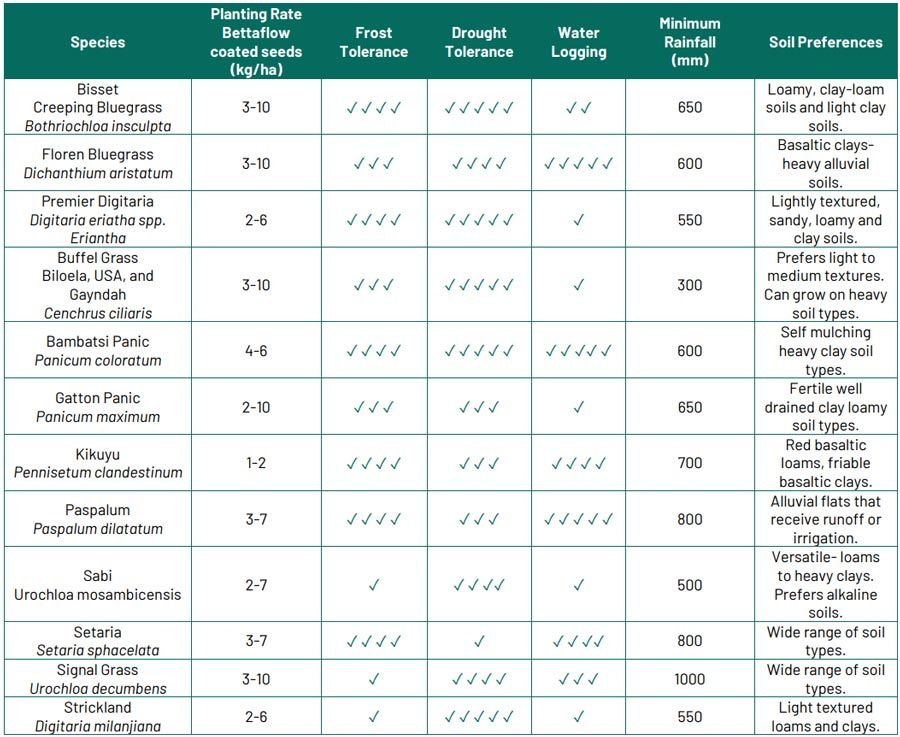Pasture Grasses
Products
Perennial tropical and subtropical grasses
Many summer crops grown today are annual tropical grasses. Perennial tropical grasses offer the same benefits as these in terms of growth response to moisture, temperature, and dry matter production. There are a wide range of species, adapted to varying conditions.
Selected Seeds’ tropical/subtropical grass breeding program has brought cultivars such as Bisset Creeping Bluegrass and Finecut Rhodes grass to the market.
Some excellent tropical grasses are:
Premier Digitaria (Digitaria eriantha)
A tussocky, very persistent, drought tolerant cultivar. Premier Digitaria tolerates fire and grows well into autumn.
Bambatsi (Panicum coloratum var. makarikariense)
A standout in heavy country, Bambatsi Panic is tussocky, high yielding and palatable. It has good drought tolerance and will tolerate waterlogging. Great for melon hole country and heavy clay soil.
Bisset Creeping Bluegrass (Bothriochloa insculpta)
Bisset Creeping Bluegrass is a late flowering, long season cultivar. It is suited to a wide range of soil types and regions. Bisset is a proven performer that even retains its palatability after frost. Making it ideal to fill the autumn/winter feed gap. Bisset Creeping Bluegrass works well when mixed with Rhodes grass.
Bisset Creeping Bluegrass Fact Sheet
Floren Bluegrass (Dichanthium aristatum)
Another heavy soil standout, Floren Bluegrass is a highly palatable, tussocky grass. It loves flooding and has good drought tolerance.
Gatton Panic (Panicum maximum)
This well-known grass is tussocky, very palatable and suited to well drained, fertile soils. It grows fast after rain.
Bermuda Couch lawn grass
Bermuda Couch is a great allrounder lawn grass. It is a vigorous grower making it ideal in high traffic areas. Suited to full sun, Couch is drought tolerant and grows well on most soil types.
Kikuyu (Pennisetum clasndestinum)
Persistent on fertile soil types, Kikuyu can produce high quality feed under heavy grazing pressure. Utilised as a permanent pasture or silage option, Kikuyu requires upwards of 800 mm per annum for maximum production.
Gayndah Buffel grass (Cenchrus ciliaris)
Gayndah Buffel grass is extremely drought tolerant. It is a proven producer on light to medium soil types. Widely used in central and northern parts of Australia, Gayndah Buffel requires a rainfall between 300-900 mm.
Gayndah Buffel grass Fact Sheet
Biloela Buffel grass (Cenchrus ciliaris)
Biloela Buffel grass grows taller and is later maturing then other Buffel types, preferring heavier soil types. Widely used in central and northern parts of Australia because of its high drought tolerance, Bilolea Buffel requires a rainfall between 300-900 mm.
Biloela Buffel grass Fact Sheet
USA Buffel grass (Cenchrus ciliaris)
Extremely drought tolerant, USA Buffel grass is best on light to medium soil types. Shorter and earlier maturing then both Biloela and Gayndah varieties, USA Buffel has a purple seedhead, making it easy to distinguish from other Buffel varieties. Widely used in central and northern parts of Australia, USA Buffel requires a rainfall between
300-900 mm.
Humidicola (Urochloa humidicola)
Humidicola is a highly competitive perennial, persistent in waterlogging and flood prone country. Used as a permanent pasture option where waterlogging can constrict growth of other grass varieties.
Keppel Bluegrass (Bothriochloa pertusa)
Keppel Bluegrass is a variety of Indian Bluegrass, that is later flowering, with finer stems. Suited for grazing or hay, Keppel Bluegrass is highly adaptable to low fertile soil types.
Paspalum (Paspalum dilatatum)
A leafy, tufted, perennial, Paspalum is usually utilised as a permanent pasture. However, it can also be used for hay or silage provided it is harvested before flowering.
Queensland Bluegrass (Dichanthium sericium)
A highly palatable, native grass, Queensland Bluegrass can be used for all classes of grazing stock and hay operations. Suited to deep fertile clay soil types, stands are less competitive with legumes then other grass species.
Queensland Bluegrass Fact Sheet
Sabi grass (Urochloa mosambicensis)
Typically used in tropical grazing systems, Sabi grass is a summer growing perennial suited to environments receiving 500-1300 mm rainfall. Extremely drought tolerant, Sabi grass has fast establishment and a good ability to spread via seeds and stolons.
Setaria (Setaria sphacelata)
A palatable grass, Setaria is adapted to a wide range of soil types. It persists under moderate grazing pressure and can self-regenerate. Highly tolerant of waterlogging and flooding Seteria prefers areas with an annual rainfall 1000 mm+ but can persist growing with rainfall as low as 700 mm.
Signal Grass (Urochloa decumbens)
A perennial, loosely tufted grass suited to a wide range of soil types. Signal grass performs well as a permanent pasture and makes excellent hay. Productive in areas receiving rainfall between 700-1300 mm, Signal grass is usually found on well-draining soil types.
Strickland (Digitaria milanjiana)
Strickland is a drought tolerate and highly palatable grass suited to most soil types. It is used as a long-term pasture, cut, and carry or hay option. Strickland can produce high dry matters 10-20 t/year under heavy grazing.
Tropical and subtropical planting guide:
Rhodes grasses:
Selected Seeds has a range of Rhodes grass products. For further information, see our Rhodes grass page.

